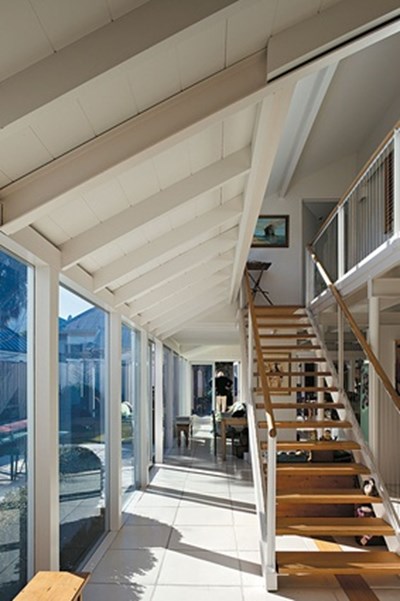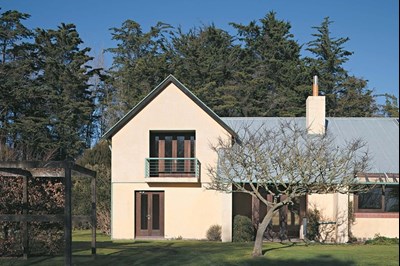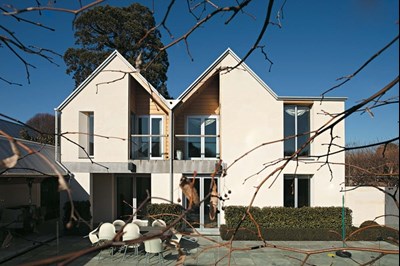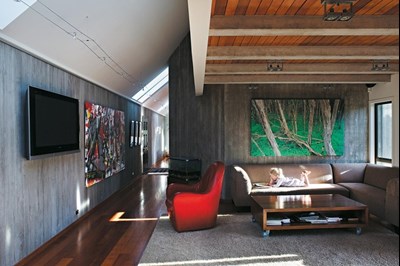Peter Beaven ‘Houses’ interview
Lyttelton Tunnel Administration Building
Photo by Paul McCredie
Error loading section
This command of ensemble is why you like the Arts Centre here, the old Canterbury University site?
That’s right, exactly.
And why you would prefer it to be left as it is?
Yes. Here we managed, in a poor lonely colony on the other side of the world, an ensemble of the sort of excellence that I’m talking about all the time. We actually did it here, in 20 years. Mountfort reinterpreted the culture he came from. He was a well-trained person, one of the good Gothic revival people. He jumped ashore showing the natural vividness that good architects have. Mountfort interpreted local materials and modified the neo-Gothic into forms which carried the spirit of the Gothic. It’s beautifully proportioned, it’s as if you’re looking at a Ruskinian abstract painting. Mountfort was remarkable, and so was [Samuel] Hurst Seager – he’s the one who really planned the old University. All this whole culture here, and so to damage it…that’s why I’m so bloody angry at Miles Warren and Ian Athfield. I respect them both, of course, but for them to attack me for wanting to save these buildings…
Which brings us to another point. There’s no avoiding the simultaneous presence in Christchurch of you and Miles Warren, nor the competition for the Christchurch Town Hall which was an important competition to win, and lose. There’s a perception that you left Christchurch because you lost that competition. Is that true?
I’ve been accused of that lots of times but, no, it wasn’t the real reason. I found the Town Hall a keen fight and I enjoyed it. Miles was bound to win. He had the best office, he had a superb design office, the best graduates. Christchurch in the ‘60s and ‘70s was a marvellous place, really, and there are other architects who never get mentioned but should be. Hall and McKenzie did the Registry Building at the University which is absolutely outstanding. Trengrove and Marshall did those two huge buildings at Lincoln University which are Corbusier astonishments set in the flat plain of Ellesmere Lake. Those two firms in particular did extraordinarily good work and never seemed to be mentioned.
Miles would naturally dominate because he wanted a big office. After he won the Town Hall he decided he would be the office of the country.
But he won the Town Hall perfectly simply because it was a tangible, clever plan, a classical plan, put together beautifully of the local materials, beautifully built and beautifully detailed. It’s a marvellous building.
My design was much more romantic, of course. It was like the Port Hills in roof outline, and Charoun and Aalto, and it was published in The Architectural Review. The article had Miles’ design on one side and mine on the other – it said 'Good manners versus fun’, or something. In fact I was the one who was asked to give the speech for the Institute of Architects congratulating Miles for winning the Town Hall competition. It’s all Christchurch fun, you know. I’ve never taken it seriously at all.
So you went to London. When was that – the late ‘70s?
I first went to London to do the urban design course at the Architectural Association in 1967. That was the year of swinging London. It was utterly wonderful. The New Zealand dollar was equal to the English pound, and I sold my little wooden yacht and we lived for a year in Hampstead. We had this wonderful townhouse. Just above us was a marvellous old woman who was the widow of Lutyen’s architect who supervised New Delhi. We got this beautiful flat because we came into the land agent straight after an Afghan pop group had been told they couldn’t have it. London is always just wonderful really. I came back to New Zealand and spent a year and a half trying to push urban design. I went to places like Hastings and the Wairarapa and Queenstown, trying to talk about urban design. But of course it’s a myth in a capitalist society, where the land is entirely controlled by greed. Urban design is the control of land for the public use and betterment. That doesn’t come into the capitalist agenda. Put that in.
It’s all going in. Seven or eight years later you returned to London.
What happened was quite straightforward really. I had a very good partnership with Burwell Hunt for about seven years. In that time we did Queen Elizabeth II Park and the Chateau on the Park Hotel in Christchurch, Habitat Housing [Thorndon Mews] in Wellington, a hotel in Queenstown. Then the partnership fell apart, and I’d got to the point of getting absolutely bone tired of Christchurch. I’d been through all the Civic Trust fights, saving Mona Vale [historic house], saving the Arts Centre. I had had one or two other disturbances of a marital and romantic kind which had thrown me a bit, and work dried up, and I just ran out of who I was at that time and who I wanted to be. I thought, 'I can’t cope with this,’ and I just left. I went to London and just trusted on my wits. I had $5,000 and some clothes and a connection with an architect over there. I just went because I wanted a change.
You weren’t some neophyte Kiwi going on his OE. You were 50, and starting again. That was a big thing.
Yes, but it seemed to be the obvious thing. I think it was a good thing, because I loved London. I built some buildings there, and did two master plans for self-build villages, in Hackney and at Limehouse. If I’d stayed to build those – they rang me up and wanted me to go back – I’d have been famous. I had a house I was going to build on the Thames. It would be worth a couple of million now. It was a different world.
You had your own practice there?
Yes, all the time. I never worked for anyone.
Where were you living?
Much of the time in Holman Hunt’s studio in Melbury Road, then Soho and Hamsptead – pretty good addresses, really.
And where was your practice based?
It was just at the end of my bed, on the drawing board. That was alright. In London there was an understanding of who you were more than here. In New Zealand it’s what you purport to be in, what the evidence is, but over there it was much more who you were and how you appeared – just your own presence and personality. It’s quite different. As I say, what I learned in the Navy all those years ago is that if you did the work and made them laugh, the English loved you. And I loved England – the context, the history, the traditions, the Gothic architecture.
Why did you come back?
It’s not a question I can fairly answer, actually because I still don’t know. There was a delay in the work I was doing, I had an emotional relationship of some intensity which fell apart, and I suddenly felt that call of New Zealand, that essential place that you can still manipulate. Then I read three books. I read Man Alone, that wonderful book by John Mulgan. He committed suicide in a Greek hotel. He couldn’t decide – he respected the vigour of the New Zealanders and the freshness and strength of them in the Second World War, but he couldn’t give up the urbane culture of Oxford, so he just committed suicide. I also read Katherine Mansfield, and was deeply aware that when her brother was killed in the First World War her writing became much more New Zealand oriented, and it was better then. I also looked at Frances Hodgkins. The times she painted most brilliantly was when she was in Spain, in colour and brightness and warmth and away from the cold closeness of England. Those were the three things really that made me think I wasn’t doing enough. My relationship had broken down. The work was held up and then suddenly I got the opportunity of two jobs in New Zealand so that brought me back here.
It seems that you have an intense attachment to this place, to Christchurch and Canterbury, but then you recoil from it sometimes. Does it get too much sometimes? Do you know what I mean?
Yes, I do. What I think it is, John, is that you get disappointed here. You’re disappointed at the failure of people to see the obvious. Things are not as I think they could be. The promises of my grandfathers don’t seem to be borne out, particularly now, of course, when what’s going on in Christchurch at the moment I find desperately sad and disappointing. But that’s just my view. I’m not going to be antagonistic.
Well, no, but your place in your profession is interesting because you seem to be of the establishment – in your upbringing and education, at least – and also scathing of it. I know you have misgivings about the direction of the Institute of Architects, for example, which has acknowledged your career with its Gold Medal. There’s an ambivalence, isn’t there, in your attitude towards the powers that be?
I think that’s fair comment. That’s perfectly true. You cannot have anarchy and you can’t have revolution. I’ve read all the books – the Russian civil wars, my favourite reading – and the idea of sweeping things away and making a complete newness is wrong, utter madness. All that I’m saying about context and history and the whole bringing together of things is not about disruption. To me the modernist movement was a disruption of a natural evolution.
When I seem to be at variance with the profession it’s only because I would like improvement. I put up the idea that the Institute should set aside a lot of its energy to be a learned society, that it be seen as a centre of understanding, of leaky homes, of energy, green issues, urban design, all these things, but it has been captured by the new neo-capitalist regime, and by large firms who now can have the libraries with all the necessary modern jargon. So the Institute is tending towards more of a corporate identity. I feel a bit angry about. But I don’t think you could say that wanting to save the Arts Centre is disruptive. I’m simply saying that if we respect our history more we’ll know ourselves more.
Because you were never a modernist you were spared the necessity of becoming a post-modernist.
Well, I didn’t have to be. Post-modernism is just a way of trying to make the work more compatible to people, but, well, [Philip] Johnson and all those people decorating their skyscrapers like Chippendale furniture – it can go on being silly to the end of its era. I’ve never been a post-modernist. My buildings grow out of the people and the locality. They’re very organic, and they’re very much part of why they’re made there.
Is it too fanciful to see, especially in your bigger buildings, a sort of neo-Gothic influence as well – their verticality, for example, the way the gaze is drawn up?
You’re on to something there, but again that comes out of context and locale. You don’t need a very good eye to see if you walk around Christchurch that the great roofs and chimneys stand on the plain beautifully, particularly with the tall English trees. I think to disrupt this bright sky with a proper roof is infinitely better than just with a flat roof and a seagull and a television aerial.
It is extraordinary that at 84 you are still practising architecture everyday. What keeps you going?
What keeps me going is a very simple thing – that I’ve still got creative work. Well, the word creative seems a bit pretentious, but work that I’m fully engaged with and delighted by. If that stopped, I’d stop. I’ve got a whole lot of fall-back things to do. I’ve got a little wooden yacht to sail round the peninsula, and I love sketching, and I love classical music, and walking and bicycling around, and books, but I just want to stop dead if I’m not doing something interesting.
You’re still getting commissions.
There’s still work coming in, and good work, proper work.
Where do the commissions come from? How do people find you?
They find me solely out of the work I’ve done in the past. They’ve seen my work, it stands quite outside fashion.
And you still have a profile in the city.
Well yes, but I don’t make it. It’s just that people ring me up and I take a stance.
Well, when the public thinks of Christchurch architects they probably still think of you and Miles Warren.
Miles and I are simply there as sort of symbolic gestures, really. The real world is quite separate from us. Miles is trying to put his large epitaph in the Arts Centre and I’m trying to stop him. That’s what we’ve done all these years, nothing special about it.
On a note of personal aesthetics, every time I see you, you’re in the same clothes. Do you have a uniform?
Yes, I do. I thought that life is difficult enough. You’re right, but if you look at my clothes they’re not foolish.There’s always a white shirt which helps the aging throat and chin and this jumper here is not just a navy jumper, it’s the famous North Sea Guernsey, and then these are the white RM Williams jeans, and these are the white merino socks made in Timaru, and the shoes are interesting. I think the company has gone out of business but I’ve got three pairs of them.
I wore these clothes since I arrived in England. I realised in England that if you wore white trousers you were immediately colonial because the English haven’t got time to wash their trousers and so wear black.
So this has been it for years?
I’ve not changed this at all. What’s the point? There are too many other things to do to be wasting time choosing clothes.
Are you still that schoolboy who hid in the macrocarpa hedge?
Well, we all must be, mustn’t we? Otherwise life would be incredibly boring. No, I find everyday new, I still do. In fact I make treats everyday, that’s what I do. I go and get the mail twice a week, so there’s a treat there. There’s a book of Virginia Woolf I want to read. I’ve ordered a couple of books at the library, then I’ll bicycle and probably meet Lesley somewhere. I see everyday as a little excitement that’s going to happen. It’s like stepping stones in the Ryoanji Garden – stepping stones to pleasure through the day.
Your relationship with Lesley is obviously hugely important.
Absolutely critical. I couldn’t survive without her really. The thing is that most of my companions are dead. All the people that I loved and had such fun with, all those old artists and writers and people I knew in Sumner, all dead or become quarrelsome and repetitive, and young people are now so buried in financial tortures that they’re not very free. I haven’t got any money really, enough to be happy with. Like me Lesley holds totally to the view of old New Zealand, the culture that we had.
Do you think that you romanticise about how New Zealand was?
I can say utterly John that I do not romanticise. My memories are so strong. Most people of my age, of course, wouldn’t have as strong a pictorial memory. I can see the streets. I can see the people moving, how they were dressed, what cars they drove, what it was like to go down to the old Gothic railway station and what it was like in the Square. There never was evidence of poverty. There were poorer people, but there was not evident poverty like there is today, and there was that magical thing of equality then. There was sense that we were none of us too separate. Until the ‘70s full employment was the criterion. That was the heart of the matter – full employment and the fact that we made as much as we could of our own. A state house was, I think, eighty per cent made in New Zealand.
These are huge issues to me – moral, ethical and social issues that now are simply not addressed at all, in my opinion. Why should I read on a Saturday morning about the billionaires in this country? Who gives a stuff? I am strongly of the feeling that probably nobody alive at ‘84 now would have such a clear visual picture of what New Zealand used to be like. In those years there was a grandeur about New Zealand. I mean that. It’s just insane reading all this bloody propaganda about how dull New Zealand was then.
You’re going to keep on for a while aren’t you?
I don’t see anything to stop me. I don’t want to be discourteous, but when you’re designing a house do you still feel in control of all the elements that you have to be in control of to complete a project? Oh yes, it’s not a problem. You see, we only work within the old ways. We hardly use new materials at all. We use Oamaru stone veneer, timber weatherboards. And most of the new by-laws that have come out are common sense really.
There’s a lot more documentation needed now.
Yes, of course, but what the councils are looking for is to be safe. I feel sorry for the councils, actually. In that leaky home business of course council officers couldn’t be expected to suddenly become day-by-day inspectors of buildings. The fact that the Labour Government set up a scenario to look for blame about the leaky buildings is absolutely bloody scandalous. What really was going on was that the 1984 change opened up the whole thing to shonky money, shonky developers, shonky builders. They clambered on to putting stucco on timber frames to put up the cheapest bloody buildings and now because they’ve all made their money, buggered off, gone bankrupt or disappeared the whole bloody scenario has landed on the councils. The Institute should have got up and said some things. It’s harder for the smaller firms now than it has ever been, and yet this is in the new capitalist liberal choice game, which of course is nonsense. As far as us coping, no, there’s no problem because we simply always work with the builder and work in the traditional patterns. Trust, in the end, is what building is about and the whole idea of building is nonsense if the builder is not responsible for his building and the architect is not responsible to the person who’s commissioning it.
You’ve chosen the right career, haven’t you? Architecture is what you should have done?
I never had any doubt. I was a natural architect. My grandfather was a builder. He wanted to be an architect. I grew up in the whole surroundings I’ve talked to you about. I was given a very good inner eye, you see. All my buildings I can see inside my head. I can walk through them like a computer walks through. I don’t know how many architects can do that. The trouble with the profession is they never really talk about what being an architect feels like.
Well, what does it feel like?
Oh, it’s a marvellous feeling. It’s the most privileged profession on earth. I mean here you are with an eye to enjoying the world, with an ear to hear properly, with a feeling for touch, with a delight in moving through light and space and air, and then to deal with builders. In the end, the builders are what make the whole thing wonderful. I’ve always believed that the builder, out in the cold and the wet in the morning, is the person you must totally respect. A builder wants to know an answer so he can get on and you’ve got to give him that answer, and it doesn’t matter how complex a building is. These buildings of mine in this article are very complex but all the builders say to me that they want to do another one because they felt they were with me and they could see what I was trying to do and I could see their problems.
Of course, bespoke architecture is a minority pursuit. It’s out of the reach of most people.
There’s nothing you can do about that. The Arts and Crafts people found that. They set up with ideals for the people but finished up with the wealthy. That’s not to say you can’t try. Actually, I am going to try to prove that it’s possible to build modestly and cheaply with a little house for ourselves. It’s a little site under the Port Hills. I’ve talked to the builder, it’s going to cost very little money and it’s going to be sustainable and its going to be beautiful and its going to be just cheap – no more than an ordinary spec house. I’ll prove that it can be done, and it might be the last thing I prove.
Further reading
Useful links
Peter Beaven: The ’60s & ’70s
http://www.architecture-archive.auckland.ac.nz/docs/block-digital/2009-07-Block-Digital-Beaven%20Guide.pdf
Modern Heritage, Andrew Barclay
http://www.warrenandmahoney.com/en/perspectives/modern-heritage-2/







